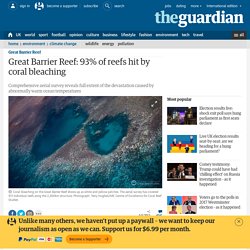

PROTECTION DES CORAUX ET MANGROVES EN MICRONÉSIE. Une plongée extraordinaire au-dessus du récif corallien de l’Amazone. Notre journaliste a embarqué avec Greenpeace à la découverte d’un massif corallien de 9 500 km² menacé par des projets pétroliers.

LE MONDE | • Mis à jour le | Par Rémi Barroux (Océan atlantique, au large de l'Amazone, envoyé spécial) Surtout, rester calme. Se rappeler que la manette verte, à gauche, permet de corriger l’oxygène. Mais qu’il ne faut surtout pas s’en servir. La noire, c’est pour la pression qui doit rester négative dans le minuscule habitacle du sous-marin qui m’entraîne, ce lundi 30 janvier, à une centaine de mètres de fond, au large de l’Amazone, à la découverte d’un récif corallien, tout juste mis à jour mais déjà menacé par des projets pétroliers. Surprising, Vibrant Reef Discovered in the Muddy Amazon. After sampling muddy water from the mouth of the Amazon River, oceanographer Patricia Yager steamed in the research ship Atlantis toward the continental shelf, where a Brazilian colleague was chasing a phantom.

Yager’s colleague was carrying a 1977 six-page research paper that included a hand-drawn map suggesting this region might mask an extraordinary set of reefs. Yager was skeptical. The mouth of the Amazon was thick with more runoff and sediment than any river in the world. She had heard diving in this area was like swimming through goopy, dark stew. "I thought that everything would have just been smothered by settling mud from the river's plume," she says. DECOUVERTE EXCEPTIONNEL MASSIF CORALIEN EMBOUCHURE AMAZONE MENACE PAR FORAGES. PETITION VITALE POUR EVITER AUX CORAUX LA DISPARITION TOTALE. Ruée dévastatrice vers l’« ivoire » de la mer de Chine. La récolte intensive de bénitiers géants, encouragée par Pékin dans des archipels disputés, détruit les récifs coralliens.

Ces tridacnes peuvent atteindre un mètre de diamètre et 200 kg. LE MONDE | • Mis à jour le | Par Brice Pedroletti (Ile de Hainan (Chine), envoyé spécial) Penché sur son établi, masque antipoussière sur le visage, l’homme trace des arabesques sur la face intérieure d’une valve de coquillage géant. Son voisin entreprend ensuite de les ciseler à la perceuse électrique.
Is the End in Sight for The World’s Coral Reefs? by J.E.N. Veron: Yale Environment 360. 06 Dec 2010: Analysis by j.e.n. veron Over the past decades, there have dozens of articles in the media describing dire futures for coral reefs.

In the 1960s and ‘70s, we were informed that many reefs were being consumed by a voracious coral predator, the crown-of-thorns starfish. In the 1980s and ‘90s, although these starfish still reared their thorny heads from time to time, the principal threats had moved on — to sediment runoff, nutrients, overfishing, and general habitat destruction. For me, an Australian marine scientist who has spent the past 40 years working on reefs the world over, these threats were of real concern, but their implications were limited in time or in space or both.
View photos Photo courtesy of J.E.N. You may well feel that dire predictions about anything almost always turn out to be exaggerations. So what are the issues? Stop à la destruction des récifs coralliens. Australie : année noire pour la Grande Barrière de corail. More than 60% of Maldives' coral reefs hit by bleaching. More than 60% of coral in reefs in the Maldives has been hit by “bleaching” as the world is gripped by record temperatures in 2016, a scientific survey suggests.

Bleaching happens when algae that lives in the coral is expelled due to stress caused by extreme and sustained changes in temperatures, turning the coral white and putting it at risk of dying if conditions do not return to normal. Unusually warm ocean temperatures due to climate change and a strong “El Nino” phenomenon that pushes up temperatures further have led to coral reefs worldwide being affected in a global bleaching event over the past two years.
Preliminary results of a survey in May this year found all the reefs looked at in the Maldives, in the Indian Ocean, were affected by high sea surface temperatures. Around 60% of all assessed coral colonies, and up to 90% in some areas, were bleached. It took place on Alifu Alifu Atholhu - North Ari Atoll - chosen as a representative atoll of the Maldives. Great Barrier Reef: 93% of reefs hit by coral bleaching. Almost 93% of reefs on the Great Barrier Reef have been hit by coral bleaching, according to a comprehensive survey revealing the full extent of the devastation caused by abnormally warm ocean temperatures sweeping the globe.

There have only been three mass bleaching events recorded on the reef , and all of them have happened since 1998. Scientists say this episode is the worst they’ve ever seen. The world is in the midst of a global bleaching event, which is a result of a pulse of warm water flowing around the Pacific Ocean caused by El Niño, and the background global warming caused by man-made greenhouse gas emissions. Corals bleach when they experience temperatures above their normal summer maximum for a month or two. The situation is made worse if there are few clouds, and a high level of UV radiation blasts the coral. The Great Barrier Reef aerial survey began last month, and has now covered 911 individual reefs along the 2,300km structure from helicopters and planes.